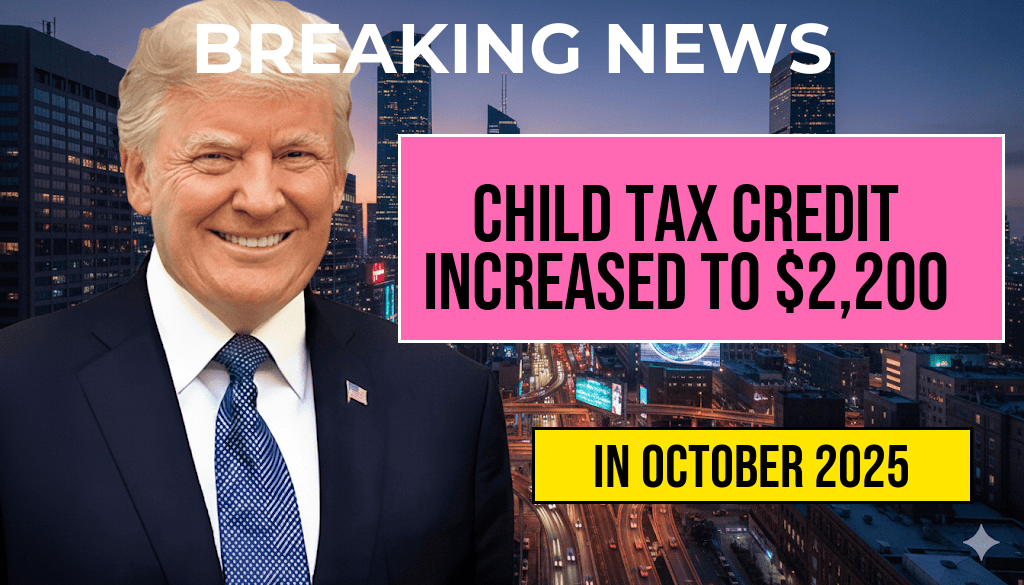The Child Tax Credit (CTC) has experienced a significant boost, increasing the maximum benefit to $2,200 per qualifying child. This enhancement aims to provide substantial financial relief to millions of families across the United States, particularly those with lower and middle incomes. The expanded credit, which was enacted as part of recent legislative efforts to support families amid ongoing economic challenges, marks a shift from previous thresholds, allowing more families to access higher benefits. The change is expected to impact approximately 39 million households, delivering an estimated $80 billion annually in additional support. This move reflects broader policy priorities focused on reducing child poverty and boosting household stability, aligning with recent discussions around family-focused economic initiatives.
Details of the Increased Child Tax Credit
How the New Benefits Work
The updated Child Tax Credit now offers a maximum of $2,200 per eligible child, which is an increase from the previous limit of $2,000. This increase applies to children under the age of 17, with full benefits available to families earning up to $75,000 annually for individuals and $150,000 for married couples filing jointly. Families with incomes slightly above these thresholds may still qualify for a partial credit, depending on their income level and number of dependents.
The credit is designed to be accessible through the IRS, with eligible families able to claim it on their annual tax returns. For those who qualify, the IRS also offers advance monthly payments, making the benefit more immediate and helping families manage ongoing expenses related to child care, education, and everyday needs.
Eligibility Criteria
- Children aged under 17 at the end of the tax year
- Residency in the United States
- Filing a valid tax return or using the IRS Non-Filer tool if not required to file
- Valid Social Security number for the child
- Household income within the specified thresholds
Impacts on Families and Broader Economy
Financial Relief and Poverty Reduction
Preliminary estimates suggest that the increased Child Tax Credit could lift approximately more than 3 million children out of poverty, according to research from the Center on Budget and Policy Priorities. By providing more substantial monthly support, families are better equipped to cover essential expenses, reducing the need for emergency aid or loans. This, in turn, could lead to improved health, educational outcomes, and overall well-being for children in affected households.
Policy Outlook and Future Considerations
Supporters argue that the boost to the Child Tax Credit represents a critical step toward addressing longstanding economic disparities. However, some policymakers debate whether the increase should be made permanent or expanded further. Advocates emphasize that sustained support could foster long-term economic stability, reduce reliance on social services, and promote upward mobility for low-income families. Opponents, meanwhile, caution about the fiscal implications and call for targeted measures to ensure the benefits reach those most in need.
Comparison with Previous Child Tax Credit Structures
| Feature | 2022 | 2023 (Post-Increase) |
|---|---|---|
| Maximum benefit per child | $2,000 | $2,200 |
| Income threshold for full benefit | $75,000 (single filers) | $75,000 (single filers) |
| Age of eligible children | Under 17 | Under 17 |
| Advance payments available | No | Yes |
Resources and Further Information
Families seeking guidance on claiming the Child Tax Credit can consult the official IRS website. For detailed eligibility criteria and updates on legislative changes, the Wikipedia entry on Child Tax Credit offers comprehensive background information. Policymakers and advocates continue to monitor the program’s impact, emphasizing the need for ongoing adjustments to maximize its effectiveness in supporting families and children across the nation.
Frequently Asked Questions
What is the new amount of the Child Tax Credit?
The Child Tax Credit has been increased to $2,200 per qualifying child, providing greater financial support to families.
Which families are eligible for the increased Child Tax Credit?
Families with qualifying children under the age of 17 who meet income requirements are eligible to receive the increased Child Tax Credit.
How does the increased Child Tax Credit benefit families?
The increase to $2,200 helps millions of families by reducing their tax burden and providing additional financial assistance for child-related expenses.
How can families claim the increased Child Tax Credit?
Families can claim the Child Tax Credit when filing their tax returns, ensuring they include the relevant information about their children to receive the benefit.
Are there any changes to the eligibility criteria for the Child Tax Credit?
Yes, the recent increase may come with updated eligibility criteria, so families should review current IRS guidelines or consult a tax professional to confirm their qualifications.






